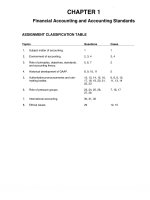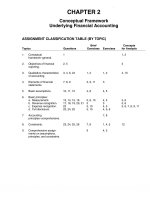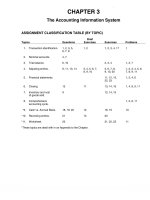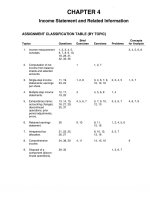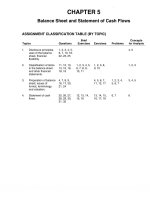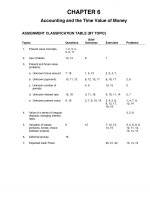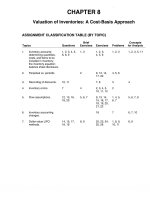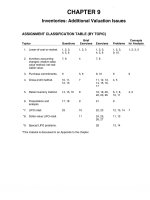Solution manual intermediate accounting 13e kieso ch15
Bạn đang xem bản rút gọn của tài liệu. Xem và tải ngay bản đầy đủ của tài liệu tại đây (414.46 KB, 76 trang )
To download more slides, ebook, solutions and test bank, visit
CHAPTER 15
Stockholders’ Equity
ASSIGNMENT CLASSIFICATION TABLE (BY TOPIC)
Topics
Questions
Brief
Exercises
Exercises
Problems
Concepts
for Analysis
1. Stockholders’ rights;
corporate form.
1, 2, 3
1
2. Stockholders’ equity.
4, 5, 6, 16,
17, 18, 29,
30, 31
3
7, 10, 16,
17
1, 2, 3, 9
3. Issuance of shares.
7, 10
1, 2, 6
1, 2, 4,
6, 9
1, 3, 4
4. Noncash stock transactions; lump sum sales.
8, 9
4, 5
3, 4, 5, 6
1, 4
2
5. Treasury stock transactions, cost method.
11, 12, 17
7, 8
3, 6, 7, 9,
10, 18
1, 2, 3,
5, 6, 7
7
6. Preferred stock.
3, 13, 14,
15
9
8
1, 3
10, 11, 17
9, 11, 12
7. Stockholders’ equity
accounts; classifications;
terminology.
8. Dividend policy.
19, 20, 21,
22, 25, 26
10
12, 15, 16
7, 10
9. Cash and stock dividends;
stock splits; property
dividends; liquidating
dividends.
22, 23, 24
10, 11, 12,
13, 14
13, 14,
15, 18
6, 7, 8,
10, 11
10. Restrictions of retained
earnings.
27, 28
4, 5, 6
9
11. Analysis
*12. Dividend preferences
and book value.
3
17, 19, 20
32
15
21, 22,
23, 24
*This material is covered in an Appendix to the chapter.
Copyright © 2010 John Wiley & Sons, Inc.
Kieso, Intermediate Accounting, 13/e, Solutions Manual
(For Instructor Use Only)
15-1
To download more slides, ebook, solutions and test bank, visit
ASSIGNMENT CLASSIFICATION TABLE (BY LEARNING OBJECTIVE)
Brief
Exercises
Learning Objectives
Exercises
Problems
1.
Discuss the characteristics of the corporate
form of organization.
2.
Identify the key components of stockholders’
equity.
3.
Explain the accounting procedures for issuing
shares of stock.
1, 2, 4, 5, 6
1, 2, 3, 4, 5, 6,
8, 9, 10
1, 3, 4, 9, 12
4.
Describe the accounting for treasury stock.
3, 7, 8
6, 7, 9, 10, 18
1, 2, 3, 5, 6,
7, 9, 12
5.
Explain the accounting for and reporting
of preferred stock.
9
5, 8
4
6.
Describe the policies used in distributing
dividends.
10, 11, 12
16
7.
Identify the various forms of dividend
distributions.
11, 12
11, 12, 15,
16, 18
3, 6, 7, 8, 9,
11, 12
8.
Explain the accounting for small and large
stock dividends, and for stock splits.
13, 14
11, 13, 14, 15,
16, 18
3, 8, 10,
11, 12
9.
Indicate how to present and analyze
stockholders’ equity.
3
17, 19, 20
1, 2, 6, 9,
11, 12
Explain the different types of preferred stock
dividends and their effect on book value
per share.
15
21, 22,
23, 24
*10.
15-2
Copyright © 2010 John Wiley & Sons, Inc.
Kieso, Intermediate Accounting, 13/e, Solutions Manual
(For Instructor Use Only)
To download more slides, ebook, solutions and test bank, visit
ASSIGNMENT CHARACTERISTICS TABLE
Item
Description
Level of
Difficulty
Time
(minutes)
E15-1
E15-2
E15-3
E15-4
E15-5
E15-6
E15-7
E15-8
E15-9
E15-10
E15-11
E15-12
E15-13
E15-14
E15-15
E15-16
E15-17
E15-18
E15-19
E15-20
*E15-21
*E15-22
*E15-23
*E15-24
Recording the issuances of common stock.
Recording the issuance of common and preferred stock.
Stock issued for land.
Lump-sum sale of stock with bonds.
Lump-sum sales of stock with preferred stock.
Stock issuances and repurchase.
Effect of treasury stock transactions on financials.
Preferred stock entries and dividends.
Correcting entries for equity transactions.
Analysis of equity data and equity section preparation.
Equity items on the balance sheet.
Cash dividend and liquidating dividend.
Stock split and stock dividend.
Entries for stock dividends and stock splits.
Dividend entries.
Computation of retained earnings.
Stockholders’ equity section.
Dividends and stockholders’ equity section.
Comparison of alternative forms of financing.
Trading on the equity analysis.
Preferred dividends.
Preferred dividends.
Preferred stock dividends.
Computation of book value per share.
Simple
Simple
Simple
Moderate
Simple
Moderate
Moderate
Moderate
Moderate
Moderate
Simple
Simple
Simple
Simple
Simple
Simple
Moderate
Moderate
Moderate
Moderate
Simple
Moderate
Complex
Moderate
15–20
15–20
10–15
20–25
10–15
25–30
15–20
15–20
15–20
20–25
15–20
10–15
10–15
10–12
10–15
05–10
20–25
30–35
20–25
15–20
10–15
15–20
15–20
10–20
Moderate
Simple
Moderate
Moderate
Moderate
Moderate
Moderate
Moderate
Simple
Moderate
Simple
Complex
50–60
25–35
25–30
20–30
30–40
30–40
15–20
20–25
20–25
35–45
25–35
35–45
Moderate
Moderate
Moderate
Simple
Simple
Moderate
Moderate
10–20
15–20
25–30
25–30
15–20
20–25
10–15
P15-1
P15-2
P15-3
P15-4
P15-5
P15-6
P15-7
P15-8
P15-9
P15-10
P15-11
P15-12
Equity transactions and statement preparation.
Treasury stock transactions and presentation.
Equity transactions and statement preparation.
Stock transactions—lump sum.
Treasury stock—cost method.
Treasury stock—cost method—equity section preparation.
Cash dividend entries.
Dividends and splits.
Stockholders’ equity section of balance sheet.
Stock dividends and stock split.
Stock and cash dividends.
Analysis and classification of equity transactions.
CA15-1
CA15-2
CA15-3
CA15-4
CA15-5
CA15-6
CA15-7
Preemptive rights and dilution of ownership.
Issuance of stock for land.
Conceptual issues—equity.
Stock dividends and splits.
Stock dividends.
Stock dividend, cash dividend, and treasury stock.
Treasury stock, ethics.
*This material is presented in an appendix to the chapter.
Copyright © 2010 John Wiley & Sons, Inc.
Kieso, Intermediate Accounting, 13/e, Solutions Manual
(For Instructor Use Only)
15-3
To download more slides, ebook, solutions and test bank, visit
SOLUTIONS TO CODIFICATION EXERCISES
CE15-1
Master Glossary
(a)
A security that is convertible into another security based on a conversion rate. For example,
convertible preferred stock that is convertible into common stock on a two-for-one basis (two
shares of common for each share of preferred).
(b)
An issuance by a corporation of its own common shares to its common shareholders without
consideration and under conditions indicating that such action is prompted mainly by a desire to
give the recipient shareholders some ostensibly separate evidence of a part of their respective
interests in accumulated corporate earnings without distribution of cash or other property that the
board of directors deems necessary or desirable to retain in the business.
(c)
An issuance by a corporation of its own common shares to its common shareholders without
consideration and under conditions indicating that such action is prompted mainly by a desire to
increase the number of outstanding shares for the purpose of effecting a reduction in their unit
market price and, thereby, of obtaining wider distribution and improved marketability of the shares.
Sometimes called a stock split-up
(d)
Contractual rights of security holders to receive dividends or returns from the security issuer’s
profits, cash flows, or returns on investments.
CE15-2
According to FASB ASC 505-20-25-3 (Stock Dividends and Stock Splits):
The point at which the relative size of the additional shares issued becomes large enough to materially
influence the unit market price of the stock will vary with individual entities and under differing market
conditions and, therefore, no single percentage can be established as a standard for determining when
capitalization of retained earnings in excess of legal requirements is called for and when it is not.
Except for a few instances, the issuance of additional shares of less than 20 or 25 percent of the
number of previously outstanding shares would call for treatment as a stock dividend as described in
paragraph 505-20-30-3.
CE15-3
According to FASB ASC 340-10-S99-1 (Deferred Costs and Other Assets—SEC Materials):
Specific incremental costs directly attributable to a proposed or actual offering of securities may properly be deferred and charged against the gross proceeds of the offering. However, management
salaries or other general and administrative expenses may not be allocated as costs of the offering and
deferred costs of an aborted offering may not be deferred and charged against proceeds of a subsequent offering. A short postponement (up to 90 days) does not represent an aborted offering.
15-4
Copyright © 2010 John Wiley & Sons, Inc.
Kieso, Intermediate Accounting, 13/e, Solutions Manual
(For Instructor Use Only)
To download more slides, ebook, solutions and test bank, visit
CE15-4
According to FASB ASC 505-30-25-7 (Treasury Stock—Recognition):
While the net asset value of the shares of common stock outstanding in the hands of the public may be
increased or decreased by such repurchase and retirement, such transactions relate to the capital of
the corporation and do not give rise to corporate profits or losses. There is no essential difference
between the following:
(a)
The repurchase and retirement of a corporation’s own common stock and the subsequent issue
of common shares.
(b)
The repurchase and resale of its own common stock.
Copyright © 2010 John Wiley & Sons, Inc.
Kieso, Intermediate Accounting, 13/e, Solutions Manual
(For Instructor Use Only)
15-5
To download more slides, ebook, solutions and test bank, visit
ANSWERS TO QUESTIONS
1.
The basic rights of each stockholder (unless otherwise restricted) are to share proportionately:
(1) in profits, (2) in management (the right to vote for directors), (3) in corporate assets upon
liquidation, and (4) in any new issues of stock of the same class (preemptive right).
2.
The preemptive right protects existing shareholders from dilution of the ownership share in the
event the corporation issues new shares.
3.
Preferred stock commonly has preference to dividends in the form of a fixed dividend rate and
a preference over common stock to remaining corporate assets in the event of liquidation.
Preferred stock usually does not give the holder the right to share in the management of the
company. Common stock is the residual security possessing the greater risk of loss and the
greater potential for gain; it is guaranteed neither dividends nor assets upon dissolution but it
generally controls the management.
4.
The distinction between paid-in capital and retained earnings is important for both legal and
economic points of view. Legally, dividends can be declared out of retained earnings in all states,
but in many states dividends cannot be declared out of paid-in capital. Economically,
management, stockholders, and others look to earnings for the continued existence and growth
of the corporation.
5.
Authorized capital stock—the total number of shares authorized by the state of incorporation for
issuance.
Unissued capital stock—the total number of shares authorized but not issued.
Issued capital stock—the total number of shares issued (distributed to stockholders).
Outstanding capital stock—the total number of shares issued and still in the hands of stockholders (issued less treasury stock).
Treasury stock—shares of stock issued and repurchased by the issuing corporation but not
retired.
6.
Par value is an arbitrary, fixed per share amount assigned to a stock by the incorporators. It is
recognized by the state of incorporation as the amount that must be paid in for each share if the
stock is to be fully paid when issued. If not fully paid, the shareholder has a contingent liability for
the discount results.
7.
The issuance for cash of no-par value common stock at a price in excess of the stated value of
the common stock is accounted for as follows:
(1) Cash is debited for the proceeds from the issuance of the common stock.
(2) Common Stock is credited for the stated value of the common stock.
(3) Additional Paid-in Capital is credited for the excess of the proceeds from the issuance of the
common stock over its stated value.
8.
The proportional method is used to allocate the lump sum received on sales of two or more
classes of securities when the fair market value or other sound basis for determining relative
value is available for each class of security. In instances where the fair value of all classes of
securities is not determinable in a lump-sum sale, the incremental method must be used. The
value of the securities is used for those classes that are known and the remainder is allocated to
the class for which the value is not known.
9.
The general rule to be applied when stock is issued for services or property other than cash is
that the property or services be recorded at either their fair market value or the fair value of the
stock issued, whichever is more clearly determinable. If neither is readily determinable, the value
to be assigned is generally established by the board of directors.
15-6
Copyright © 2010 John Wiley & Sons, Inc.
Kieso, Intermediate Accounting, 13/e, Solutions Manual
(For Instructor Use Only)
To download more slides, ebook, solutions and test bank, visit
Questions Chapter 15 (Continued)
10.
The direct costs of issuing stock, such as underwriting costs, accounting and legal fees, printing
costs, and taxes, should be reported as a reduction of the amounts paid in. Issue costs are therefore debited to Paid-in Capital in Excess of Par because they are unrelated to corporate operations.
11.
The major reasons for purchasing its own shares are: (1) to provide tax-efficient distributions of
excess cash to shareholders, (2) to increase earnings per share and return on equity, (3) to provide
stock for employee stock compensation contracts, (4) to thwart takeover attempts or reduce the
number of stockholders, (5) to make a market in the company’s stock, and (6) to contract the
operations of the business.
12. (a)
Treasury stock should not be classified as an asset since a corporation cannot own itself.
(b)
The “gain” or “loss” on sale of treasury stock should not be treated as additions to or
deductions from income. If treasury stock is carried in the accounts at cost, these so-called
gains or losses arise when the treasury stock is sold. These “gains” or “losses” should be
considered as additions to or reductions of paid-in capital. In some instances, the “loss”
should be charged to Retained Earnings. “Gains” or “losses” arising from treasury stock
transactions are not included as a component of net income since dealings in treasury
stock represent capital transactions.
(c)
Dividends on treasury stock should never be included as income, but should be credited
directly to retained earnings, against which they were incorrectly charged. Since treasury
stock cannot be considered an asset, dividends on treasury stock are not properly included
in net income.
13.
The character of preferred stock can be altered by being cumulative or noncumulative, participating or nonparticipating, convertible or nonconvertible, and/or callable or noncallable.
14.
Nonparticipating means the security holder is entitled to no more than the specified fixed dividend.
If the security is partially participating, it means that in addition to the specified fixed dividend the
security may participate with the common stock in dividends up to a certain stated rate or
amount. A fully participating security shares pro rata with the common stock dividends declared
without limitation. In this case, Dagwood Inc. has a fully participating preferred stock. Cumulative
means dividends not paid in any year must be made up in a later year before any profits can be
distributed to common stockholders. Any dividends not paid on cumulative preferred stock
constitute a dividend in arrears. A dividend in arrears is not a liability until the board of directors
declares a dividend.
15.
Preferred stock is generally reported at par value as the first item in the stockholders’ equity
section of a company’s balance sheet. Any excess over par value is reported as part of additional
paid-in capital.
16.
Additional paid-in capital results from: (1) premiums on stock issued, (2) sale of treasury stock
above cost, (3) recapitalizations or revisions in the capital structure, (4) assessments on stockholders, (5) conversion of convertible bonds or preferred stock, and (6) declaration of a small
stock dividend.
17.
When treasury stock is purchased, the Treasury Stock account is debited and Cash is credited at
cost ($290,000 in this case). Treasury Stock is a contra stockholders’ equity account and Cash
is an asset. Thus, this transaction has: (a) no effect on net income, (b) decreases total assets,
(c) has no effect on total paid-in capital, and (d) decreases total stockholders’ equity.
*
Copyright © 2010 John Wiley & Sons, Inc.
Kieso, Intermediate Accounting, 13/e, Solutions Manual
(For Instructor Use Only)
15-7
To download more slides, ebook, solutions and test bank, visit
Questions Chapter 15 (Continued)
18.
The answers are summarized in the table below:
Account
(a) Common Stock
(b) Retained Earnings
(c) Paid-in Capital in Excess of Par Value
(d) Treasury Stock
(e)
(f)
(g)
Paid-in Capital from Treasury Stock
Paid-in Capital in Excess of Stated Value
Preferred Stock
Classification
Paid-in capital—capital stock
Retained earnings
Paid-in capital—additional paid-in capital
Deducted from total paid-in capital and
retained earnings
Paid-in capital—additional paid-in capital
Paid-in capital—additional paid-in capital
Paid-in capital—capital stock
19.
The dividend policy of a company is influenced by (1) the availability of cash, (2) the stability of
earnings, (3) current earnings, (4) prospective earnings, (5) the existence or absence of contractual
restrictions on working capital or retained earnings, and (6) a retained earnings balance.
20.
In declaring a dividend, the board of directors must consider the condition of the corporation such
that a dividend is (1) legally permissible and (2) economically sound.
In general, directors should give consideration to the following factors in determining the legality
of a dividend declaration:
(1) Retained earnings, unless legally encumbered in some manner, is usually the correct basis
for dividend distribution.
(2) Revaluation capital is seldom the correct basis for dividends (except possibly stock dividends).
(3) In some states, additional paid-in capital may be used for dividends, although such dividends
may be limited to preferred stock.
(4) Deficits in retained earnings and debits in paid-in capital accounts must be restored before
payment of any dividends.
(5) Dividends in some states may not reduce retained earnings below the cost of treasury
stock held.
In order that dividends be economically sound, the board of directors should consider: (1) the
availability (liquidity) of assets for distribution; (2) agreements with creditors; (3) the effect of
a dividend on investor perceptions (e.g. maintaining an expected “pay-out ratio”); and (4) the size
of the dividend with respect to the possibility of paying dividends in future bad years. In addition,
the ability to expand or replace existing facilities should be considered.
21.
Cash dividends are paid out of cash. A balance must exist in retained earnings to permit a legal
distribution of profits, but having a balance in retained earnings does not ensure the ability to pay
a dividend if the cash situation does not permit it.
22.
A cash dividend is a distribution in cash while a property dividend is a distribution in assets
other than cash. Any dividend not based on retained earnings is a liquidating dividend. A stock
dividend is the issuance of additional shares of the corporation’s stock in a nonreciprocal exchange
involving existing stockholders with no change in the par or stated value.
23.
A stock dividend results in the transfer from retained earnings to paid-in capital of an amount
equal to the market value of each share (if the dividend is less than 20–25%) or the par value of
each share (if the dividend is greater than 20–25%). No formal journal entries are required for
a stock split, but a notation in the ledger accounts would be appropriate to show that the par
value of the shares has changed.
15-8
Copyright © 2010 John Wiley & Sons, Inc.
Kieso, Intermediate Accounting, 13/e, Solutions Manual
(For Instructor Use Only)
To download more slides, ebook, solutions and test bank, visit
Questions Chapter 15 (Continued)
24. (a) A stock split effected in the form of a dividend is a distribution of corporate stock to present
stockholders in proportion to each stockholder’s current holdings and can be expected to
cause a material decrease in the market value per share of the stock. GAAP specifies that a
distribution in excess of 20% to 25% of the number of shares previously outstanding would
cause a material decrease in the market value. This is a characteristic of a stock split as
opposed to a stock dividend, but, for legal reasons, the term “dividend” must be used for this
distribution. From an accounting viewpoint, it should be disclosed as a stock split effected in
the form of a dividend because it meets the accounting definition of a stock split as explained
above.
(b) The stock split effected in the form of a dividend differs from an ordinary stock dividend in
the amount of other paid-in capital or retained earnings to be capitalized. An ordinary stock
dividend involves capitalizing (charging) retained earnings equal to the market value of the
stock distributed. A stock split effected in the form of a dividend involves charging retained
earnings for the par (stated) value of the additional shares issued.
Another distinction between a stock dividend and a stock split is that a stock dividend
usually involves distributing additional shares of the same class of stock with the same par
or stated value. A stock split usually involves distributing additional shares of the same class
of stock but with a proportionate reduction in par or stated value. The aggregate par or
stated value would then be the same before and after the stock split.
(c) A declared but unissued stock dividend should be classified as part of paid-in capital rather
than as a liability in a statement of financial position. A stock dividend affects only capital
accounts; that is, retained earnings is decreased and paid-in capital is increased. Thus,
there is no debt to be paid, and, consequently, there is no severance of corporate assets
when a stock dividend is issued. Furthermore, stock dividends declared can be revoked by
a corporation’s board of directors any time prior to issuance. Finally, the corporation usually
will formally announce its intent to issue a specific number of additional shares, and these
shares must be reserved for this purpose.
25.
A partially liquidating dividend will be debited both to Retained Earnings and Paid-in Capital in
Excess of Par. The portion of dividends that is a return of capital should be debited to Paid-in
Capital in Excess of Par.
26.
A property dividend is a nonreciprocal transfer of nonmonetary assets between an enterprise and
its owners. A transfer of a nonmonetary asset to a stockholder or to another entity in a nonreciprocal transfer should be recorded at the fair value of the asset transferred, and a gain or loss
should be recognized on the disposition of the asset.
27.
Retained earnings are restricted because of legal or contractual restrictions, or the necessity to
protect the working capital position.
28.
Restrictions of retained earnings are best disclosed in a note to the financial statements. This
allows a more complete explanation of the restriction.
29.
The primary iGAAP reporting standards related to stockholders’ equity are IAS 1 (Presentation of
Financial Statement), IAS 32 (Financial Instruments: Presentation), and IAS 39 (Financial
Instruments: Recognition and Measurement).
30.
Key similarities between iGAAP and U.S. GAAP for transactions related to stockholders’ equity
pertain to (1) issuance of shares, (2) purchase of treasury stock, (3) declaration and payment of
dividends, (4) the accounting for start up costs—that is, they should be expensed as incurred,
(5), the costs associated with issuing stock reduce the proceeds from the issuance and reduce
paid in capital, and (6) the accounting for par, no par and no par stock with a stated value.
Copyright © 2010 John Wiley & Sons, Inc.
Kieso, Intermediate Accounting, 13/e, Solutions Manual
(For Instructor Use Only)
15-9
To download more slides, ebook, solutions and test bank, visit
Questions Chapter 15 (Continued)
Major differences relate to terminology used, introduction of items such as revaluation surplus,
and presentation of stockholder equity information. In addition, the accounting for treasury stock
retirements differs between iGAAP and U.S. GAAP. Under U.S. GAAP a company has the option
of charging the excess of the cost of treasury stock over par value to (1) retained earnings, (2)
allocate the difference between paid in capital and retained earnings, or (3) charge the entire
amount to paid-in capital. Under iGAAP, the excess may have to be charged to paid-in capital,
depending on the original transaction related to the issuance of the stock. An iGAAP/U.S. GAAP
difference relates to the account Revaluation Surplus. Revaluation surplus arises under iGAAP
because companies are permitted to revalue their property, plant and equipment to fair value under
certain circumstances. This account is part of general reserves under iGAAP and is not considered
contributed capital. While both iGAAP and U.S. GAAP consider the statement of stockholders’
equity a primary financial statement, under iGAAP, a company has the option of preparing a statement of stockholders’ equity similar to U.S. GAAP or preparing a statement of recognized income
and expense (SoRIE). The statement of SoRIE reports the items that were charged directly to
equity such as revaluation surplus and then adds the net income for the period to arrive at total
recognized income and expense. In this situation, additional note disclosure is required to provide
reconciliations of other equity items.
31.
It is likely that the statement of stockholders’ equity and its presentation will be examined closely
in the financial statement presentation project. The statement of recognized income and expense
now permitted under iGAAP will probably be eliminated. In addition the options of how to present
other comprehensive income under U.S. GAAP will change in any converged standard in this
area. Also, the FASB has been working on a standard that will likely converge to iGAAP in the
area of hybrid financial instruments.
*32.
(a)
Preferred
$ 7,000
9,000
$16,000
Current year’s dividend, 7%
Participating dividend of 9%
Totals
Common
$21,000a
27,000
$48,000
Total
$28,000
36,000
$64,000
a
(see schedule below for computation of amounts)
The participating dividend was determined as follows:
Current year’s dividend:
Preferred, 7% of $100,000 = $ 7,000
Common, 7% of $300,000 = 21,000
$28,000
Amount available for participation
($64,000 – $28,000)
$36,000
Par value of stock that is to participate
($100,000 + $300,000)
$400,000
Rate of participation
($36,000 ÷ $400,000)
Participating dividend:
Preferred, 9% of $100,000
Common, 9% of $300,000
Dividends
15-10
Copyright © 2010 John Wiley & Sons, Inc.
9%
$ 9,000
27,000
$36,000
Kieso, Intermediate Accounting, 13/e, Solutions Manual
(For Instructor Use Only)
To download more slides, ebook, solutions and test bank, visit
Questions Chapter 15 (Continued)
(b)
Dividends in arrears, 7% of $100,000
Current year’s dividend, 7%
Participating dividend 7.25% ($29,000 ÷ $400,000)*
Totals
Preferred
$ 7,000
7,000
7,250
$21,250
Common
Preferred
$2,000
7,000
Common
$21,000
21,750
$42,750
Total
$ 7,000
28,000
29,000
$64,000
*(The same type of schedule as shown in (a)
could be used here)
(c)
Dividends in arrears ($100,000 X 7%) – $5,000
Current year’s dividend, 7%
Remainder to common
Totals
Copyright © 2010 John Wiley & Sons, Inc.
$9,000
Kieso, Intermediate Accounting, 13/e, Solutions Manual
$21,000
$21,000
(For Instructor Use Only)
Total
$ 2,000
7,000
21,000
$30,000
15-11
To download more slides, ebook, solutions and test bank, visit
SOLUTIONS TO BRIEF EXERCISES
BRIEF EXERCISE 15-1
Cash..................................................................................................
Common Stock (300 X $10)..............................................
Paid-in Capital in Excess of Par.....................................
4,500
3,000
1,500
BRIEF EXERCISE 15-2
(a) Cash.........................................................................................
Common Stock—No-Par Value..............................
8,200
(b) Cash.........................................................................................
Common Stock (600 X $2) .......................................
Paid-in Capital in Excess of Stated Value..........
8,200
8,200
1,200
7,000
BRIEF EXERCISE 15-3
WILCO CORPORATION
Stockholders’ Equity
December 31, 2010
Common stock, $5 par value....................................................
Paid-in capital in excess of par ...............................................
Total paid-in capital.....................................................................
Retained earnings........................................................................
$ 510,000
1,320,000
1,830,000
2,340,000
4,170,000
(90,000)
$4,080,000
Less: Treasury stock ..................................................................
Total stockholders’ equity................................................
BRIEF EXERCISE 15-4
Cash..................................................................................................
Preferred Stock (100 X $50) .............................................
Paid-in Capital in Excess of Par—Preferred ..............
Common Stock (300 X $10)..............................................
Paid-in Capital in Excess of Par—Common...............
13,500
FMV of common (300 X $20).....................................................
FMV of preferred (100 X $90)....................................................
Total FMV ...............................................................................
$ 6,000
9,000
$15,000
15-12
Copyright © 2010 John Wiley & Sons, Inc.
5,000
3,100
3,000
2,400
Kieso, Intermediate Accounting, 13/e, Solutions Manual
(For Instructor Use Only)
To download more slides, ebook, solutions and test bank, visit
BRIEF EXERCISE 15-4 (Continued)
Allocated to common
$6,000
X $13,500 = $ 5,400
$15,000
Allocated to preferred
$9,000
X $13,500 = 8,100
$15,000
$13,500
BRIEF EXERCISE 15-5
Land .................................................................................................
Common Stock (3,000 X $5) ............................................
Paid-in Capital in Excess of Par ....................................
31,000
15,000
16,000
BRIEF EXERCISE 15-6
Cash ($60,000 – $1,500) ..............................................................
Common Stock (2,000 X $10)...........................................
Paid-in Capital in Excess of Par .....................................
58,500
20,000
38,500
BRIEF EXERCISE 15-7
7/1/10
9/1/10
11/1/10
Treasury Stock (100 X $87) ....................................
Cash......................................................................
8,700
Cash (60 X $90) ..........................................................
Treasury Stock (60 X $87) .............................
Paid-in Capital from Treasury Stock..........
5,400
Cash (40 X $83) ..........................................................
Paid-in Capital from Treasury Stock ..................
Treasury Stock (40 X $87) .............................
3,320
160
Copyright © 2010 John Wiley & Sons, Inc.
Kieso, Intermediate Accounting, 13/e, Solutions Manual
8,700
5,220
180
3,480
(For Instructor Use Only)
15-13
To download more slides, ebook, solutions and test bank, visit
BRIEF EXERCISE 15-8
8/1/10
11/1/10
Treasury Stock (200 X $80) ..............................
Cash ................................................................
16,000
Cash (200 X $70) ..................................................
Retained Earnings...............................................
Treasury Stock ............................................
14,000
2,000
16,000
16,000
BRIEF EXERCISE 15-9
Cash.............................................................................................
Preferred Stock (500 X $100)......................................
Paid-in Capital in Excess of Par—Preferred .........
61,500
50,000
11,500
BRIEF EXERCISE 15-10
Aug. 1 Retained Earnings (2,000,000 X $1.00) ......... 2,000,000
Dividends Payable ....................................
2,000,000
Aug. 15 No entry.
Sep. 9
Dividends Payable............................................... 2,000,000
Cash...............................................................
2,000,000
BRIEF EXERCISE 15-11
Sep. 21
Available-for-Sale Securities ...........................
Gain on Appreciation of
Securities ($1,200,000 – $875,000).......
325,000
325,000
Retained Earnings ............................................... 1,200,000
Property Dividends Payable ..................
Oct. 8
No entry.
Oct. 23
Property Dividends Payable............................. 1,200,000
Available-for-Sale Securities .................
15-14
Copyright © 2010 John Wiley & Sons, Inc.
Kieso, Intermediate Accounting, 13/e, Solutions Manual
1,200,000
1,200,000
(For Instructor Use Only)
To download more slides, ebook, solutions and test bank, visit
BRIEF EXERCISE 15-12
Apr. 20
June 1
Retained Earnings ($500,000 – $125,000) ......
Paid-in Capital in Excess of Par ........................
Dividends Payable .......................................
375,000
125,000
Dividends Payable .................................................
Cash .................................................................
500,000
500,000
500,000
BRIEF EXERCISE 15-13
Declaration Date.
Retained Earnings ..................................................................... 1,300,000
Common Stock Dividend Distributable ...................
200,000
Paid-in Capital in Excess of Par.................................
1,100,000
(20,000 X $65 = $1,300,000;
(20,000 X $10 = $200,000)
Distribution Date.
Common Stock Dividend Distributable..............................
Common Stock ................................................................
200,000
200,000
BRIEF EXERCISE 15-14
Declaration Date.
Retained Earnings ..................................................................... 4,000,000
Common Stock Dividend Distributable
(400,000 X $10) .............................................................
4,000,000
Distribution Date.
Common Stock Dividend Distributable.............................. 4,000,000
Common Stock ................................................................
4,000,000
Copyright © 2010 John Wiley & Sons, Inc.
Kieso, Intermediate Accounting, 13/e, Solutions Manual
(For Instructor Use Only)
15-15
To download more slides, ebook, solutions and test bank, visit
*BRIEF EXERCISE 15-15
(a)
Preferred stockholders would receive $60,000 (6% X $1,000,000) and
the remainder of $240,000 ($300,000 – $60,000) would be distributed to
common stockholders.
(b)
Preferred stockholders would receive $180,000 (6% X $1,000,000 X 3)
and the remainder of $120,000 would be distributed to the common
stockholders.
15-16
Copyright © 2010 John Wiley & Sons, Inc.
Kieso, Intermediate Accounting, 13/e, Solutions Manual
(For Instructor Use Only)
To download more slides, ebook, solutions and test bank, visit
SOLUTIONS TO EXERCISES
EXERCISE 15-1 (15–20 minutes)
(a) Jan. 10
Mar.
July
1
1
Sept. 1
(b) Jan. 10
Mar.
1
Cash (80,000 X $6)......................................
Common Stock (80,000 X $3) ..........
Paid-in Capital in Excess of Par .....
480,000
Organization Expense...............................
Common Stock (5,000 X $3).............
Paid-in Capital in Excess of Par .....
35,000
Cash (30,000 X $8)......................................
Common Stock (30,000 X $3) ..........
Paid-in Capital in Excess of Par
(30,000 X $5) .....................................
240,000
Cash (60,000 X $10)....................................
Common Stock (60,000 X $3) ..........
Paid-in Capital in Excess of Par
(60,000 X $7) .....................................
600,000
Cash (80,000 X $6)......................................
Common Stock (80,000 X $2) ..........
Paid-in Capital in Excess of
Stated Value (80,000 X $4) ...........
480,000
Organization Expense...............................
Common Stock (5,000 X $2).............
Paid-in Capital in Excess of
Stated Value......................................
35,000
240,000
240,000
15,000
20,000
90,000
150,000
180,000
420,000
160,000
320,000
10,000
25,000
($35,000 – $10,000 or 5,000 X $5)
July
1
Cash (30,000 X $8)......................................
Common Stock (30,000 X $2)...........
Paid-in Capital in Excess of
Stated Value (30,000 X $6) ...........
Copyright © 2010 John Wiley & Sons, Inc.
Kieso, Intermediate Accounting, 13/e, Solutions Manual
240,000
60,000
180,000
(For Instructor Use Only)
15-17
To download more slides, ebook, solutions and test bank, visit
EXERCISE 15-1 (Continued)
Sept. 1
Cash (60,000 X $10) ....................................
Common Stock (60,000 X $2)...........
Paid-in Capital in Excess of
Stated Value (60,000 X $8)............
600,000
120,000
480,000
EXERCISE 15-2 (15–20 minutes)
Jan. 10
Mar.
1
April 1
May
1
Aug. 1
15-18
Cash (80,000 X $5)................................................
Common Stock (80,000 X $2) ....................
Paid-in Capital in Excess of Stated
Value—Common Stock
(80,000 X $3) ...............................................
400,000
Cash (5,000 X $108) .............................................
Preferred Stock (5,000 X $50)....................
Paid-in Capital in Excess of Par
Value—Preferred Stock
(5,000 X $58) ...............................................
540,000
Land ..........................................................................
Common Stock (24,000 X $2) ....................
Paid-in Capital in Excess of Stated
Value—Common Stock
($80,000 – $48,000)...................................
80,000
Cash (80,000 X $7)................................................
Common Stock (80,000 X $2) ....................
Paid-in Capital in Excess of Stated
Value—Common Stock
(80,000 X $5) ...............................................
560,000
Organization Expense ........................................
Common Stock (10,000 X $2) ....................
Paid-in Capital in Excess of Stated
Value—Common Stock
($50,000 – $20,000)...................................
50,000
Copyright © 2010 John Wiley & Sons, Inc.
160,000
240,000
250,000
290,000
48,000
32,000
160,000
400,000
Kieso, Intermediate Accounting, 13/e, Solutions Manual
20,000
30,000
(For Instructor Use Only)
To download more slides, ebook, solutions and test bank, visit
EXERCISE 15-2 (Continued)
Sept. 1
Nov.
1
Cash (10,000 X $9) ...............................................
Common Stock (10,000 X $2)....................
Paid-in Capital in Excess of Stated
Value—Common Stock
(10,000 X $7)...............................................
90,000
Cash (1,000 X $112).............................................
Preferred Stock (1,000 X $50) ...................
Paid-in Capital in Excess of Par
Value—Preferred Stock
(1,000 X $62)...............................................
112,000
20,000
70,000
50,000
62,000
EXERCISE 15-3 (10–15 minutes)
(a) Land ($60 X 25,000) .......................................................... 1,500,000
Treasury Stock ($48 X 25,000) .............................
Paid-in Capital from Treasury Stock .................
1,200,000
300,000
(b) One might use the cost of treasury stock. However, this is not a
relevant measure of this economic event. Rather, it is a measure of a
prior, unrelated event. The appraised value of the land is a reasonable
alternative (if based on appropriate fair value estimation techniques).
However, it is an appraisal as opposed to a market-determined price.
The trading price of the stock is probably the best measure of fair
value in this transaction.
EXERCISE 15-4 (20–25 minutes)
(a) (1) Unamortized Bond Issue Costs
($340,000 X $500/$850)........................................ 200,000
Cash ($850 X 9,600).................................................. 8,160,000
Bonds Payable..................................................
Common Stock (100,000 X $5) ....................
Paid-in Capital in Excess of Par .................
5,000,000
500,000
2,860,000
Assumes bonds are properly priced and issued at par; the residual
attributed to common stock has a questionable measure of fair value.
Copyright © 2010 John Wiley & Sons, Inc.
Kieso, Intermediate Accounting, 13/e, Solutions Manual
(For Instructor Use Only)
15-19
To download more slides, ebook, solutions and test bank, visit
EXERCISE 15-4 (Continued)
Incremental method
Lump-sum receipt (9,600 X $850) ..................................
Allocated to subordinated debenture
(9,600 X $500)....................................................................
Balance allocated to common stock ............................
$8,160,000
4,800,000
$3,360,000
Computation of common stock and paid-in capital
Balance allocated to common stock ............................
Less: Common stock (10,000 X $5 X 10) .....................
Paid-in capital in excess of par. .....................................
$3,360,000
500,000
$2,860,000
Lump-sum receipt (10,000 X $850) ................................
Allocated to debenture (10,000 X $500) .......................
Balance allocated to common stock ............................
$8,500,000
5,000,000
$3,500,000
Bond issue cost allocation
Total issue cost (400 X $850) ..........................................
Less: Amount allocated to bonds .................................
Amount allocated to common.........................................
$340,000
200,000
$140,000
Investment banking costs 400 @ $850 = $340,000 allocate 5/8.5 to
debentures and 3.5/8.5 to common stock. Bond portion is bond
issue costs; common stock portion is a reduction of paid-in capital,
which means that total paid-in capital is $3,360,000 ($3,500,000 –
$140,000).
(2) Cash..............................................................................
Unamortized Bond Issue Costs...........................
Bond Discount ($5,000,000 – $4,722,222) ........
Bonds Payable .................................................
Common Stock (100,000 X $5)....................
Paid-in Capital in Excess of Par.................
8,160,000
188,889
277,778
The allocation based on fair value for one unit is
Subordinated debenture ...............................
Common stock (10 shares X $40)..............
Total fair value..................................................
5,000,000
500,000
3,126,667
$500
400
$900
Therefore 5/9 is allocated to the bonds and 4/9 to the common stock.
15-20
Copyright © 2010 John Wiley & Sons, Inc.
Kieso, Intermediate Accounting, 13/e, Solutions Manual
(For Instructor Use Only)
To download more slides, ebook, solutions and test bank, visit
EXERCISE 15-4 (Continued)
$8,500,000 X (5/9) = $4,722,222 To Debentures
$8,500,000 X (4/9) = $3,777,778 To Common
$340,000 X (5/9) = $188,889
$340,000 X (4/9) = $151,111
Paid-in capital in excess of par = $3,777,778 – $500,000 – $151,111
= $3,126,667
(b) One is not better than the other, but would depend on the relative
reliability of the valuations for the stocks and bonds. This question is
presented to stimulate some thought and class discussion.
EXERCISE 15-5 (10–15 minutes)
(a) Fair value of Common (500 X $168)...........................................
Fair value of Preferred (100 X $210) ..........................................
$ 84,000
21,000
$105,000
Allocated to Common: $84,000/$105,000 X $100,000 .........
Allocated to Preferred: $21,000/$105,000 X $100,000.........
Total allocation .................................................................................
$ 80,000
20,000
$100,000
Cash .....................................................................................
Common Stock (500 X $10) ...................................
Paid-in Capital in Excess of Par—
Common ($80,000 – $5,000)..............................
Preferred Stock (100 X $100) ................................
Paid-in Capital in Excess of Par—
Preferred ($20,000 – $10,000) ..........................
100,000
5,000
75,000
10,000
10,000
(b) Lump-sum receipt
Allocated to common (500 X $170)
Balance allocated to preferred
Cash .....................................................................................
Common Stock..........................................................
Paid-in Capital in Excess of Par—
Common ($85,000 – $5,000)..............................
Preferred Stock .........................................................
Paid-in Capital in Excess of Par—
Preferred ($15,000 – $10,000)...........................
Copyright © 2010 John Wiley & Sons, Inc.
Kieso, Intermediate Accounting, 13/e, Solutions Manual
$100,000
85,000
$ 15,000
100,000
5,000
80,000
10,000
5,000
(For Instructor Use Only)
15-21
To download more slides, ebook, solutions and test bank, visit
EXERCISE 15-6 (25–30 minutes)
(a) Cash [(5,000 X $45) – $7,000] ..........................................
Common Stock (5,000 X $10) .................................
Paid-in Capital in Excess of Par ............................
218,000
(b) Land (1,000 X $46)...............................................................
Common Stock (1,000 X $10) .................................
Paid-in Capital in Excess
of Par ($46,000 – $10,000) ....................................
46,000
50,000
168,000
10,000
36,000
Note: The fair value of the stock ($46,000) is used to value the exchange
because it is a more objective measure than the appraised value of the
land ($50,000).
(c) Treasury Stock (500 X $44) ..............................................
Cash................................................................................
22,000
22,000
EXERCISE 15-7 (15–20 minutes)
Stockholders’ Paid-in Retained
Net
# Assets Liabilities
Equity
Capital Earnings Income
1.
D
NE
D
NE
NE
NE
2.
I
NE
I
NE
D
NE
3.
I
NE
I
I
NE
NE
EXERCISE 15-8 (15–20 minutes)
(a) $1,000,000 X 6% = $60,000; $60,000 X 3 = $180,000. The cumulative
dividend is disclosed in a note to the stockholders’ equity section; it is
not reported as a liability.
(b) Preferred Stock (3,000 X $100) ....................................
Common Stock (3,000 X 7 X $10).......................
Paid-in Capital in Excess of Par Value—
Common ................................................................
300,000
210,000
90,000
(c) Paid-in capital
Preferred stock, $100 par 6%, 10,000 shares issued....... $1,000,000
Paid-in capital in excess of par (10,000 X $7) ....................
70,000
15-22
Copyright © 2010 John Wiley & Sons, Inc.
Kieso, Intermediate Accounting, 13/e, Solutions Manual
(For Instructor Use Only)
To download more slides, ebook, solutions and test bank, visit
EXERCISE 15-9 (15–20 minutes)
May 2
10
15
31
Cash...........................................................................
Common Stock (12,000 X $10).................
Paid-in Capital in Excess of Par—
Common Stock (12,000 X $6)...............
192,000
Cash...........................................................................
Preferred Stock (10,000 X $30) ................
Paid-in Capital in Excess of Par—
Preferred Stock (10,000 X $30)............
600,000
Treasury Stock.......................................................
Cash..................................................................
14,000
Cash...........................................................................
Treasury Stock (500 X $14) .......................
Paid-in Capital from Treasury
Stock (500 X $3) .......................................
8,500
120,000
72,000
300,000
300,000
14,000
7,000
1,500
EXERCISE 15-10 (20–25 minutes)
(a) (1) The par value is $2.50. This amount is obtained from either of the
following: 2011—$545 ÷ 218 or 2010—$540 ÷ 216.
(2) The cost of treasury shares was higher in 2011. The cost at
December 31, 2011 was $42 per share ($1,428 ÷ 34) compared to
the cost at December 31, 2010 of $34 per share ($918 ÷ 27).
(b) Stockholders’ equity (in millions of dollars)
Paid-in capital
Common stock, $2.50 par value, 500,000,000
shares authorized, 218,000,000 shares issued,
and 184,000,000 shares outstanding ..........................
Additional paid-in capital ....................................................
Total paid-in capital......................................................
Retained earnings...........................................................................
Total paid-in capital and retained earnings..........
Less: Cost of treasury stock (34,000,000 shares)...............
Total stockholders’ equity .........................................
Copyright © 2010 John Wiley & Sons, Inc.
Kieso, Intermediate Accounting, 13/e, Solutions Manual
$
545
891
1,436
7,167
8,603
(1,428)
$ 7,175
(For Instructor Use Only)
15-23
To download more slides, ebook, solutions and test bank, visit
EXERCISE 15-11 (15–20 minutes)
Item
Assets Liabilities
1.
2.
3.
4.
5.
6.
7.
8.
9.
I
NE
NE
NE
D
D
NE
NE
NE
Stockholders’ Paid-in
Equity
Capital
NE
NE
I
NE
NE
D
I
NE
NE
I
NE
D
NE
D
NE
D
NE
NE
NE
NE
NE
NE
NE
NE
NE
I
NE
Retained
Earnings
Net
Income
I
NE
D
NE
D
NE
D
D
NE
I
NE
NE
NE
D
NE
D
NE
NE
EXERCISE 15-12 (10–15 minutes)
(a)
(b)
15-24
6/1
Retained Earnings ................................... 6,000,000
Dividends Payable.........................
6/14
No entry on date of record.
6/30
Dividends Payable ................................... 6,000,000
Cash ...................................................
6,000,000
6,000,000
If this were a liquidating dividend, the debit entry on the date of
declaration would be to Additional Paid-in Capital rather than Retained
Earnings.
Copyright © 2010 John Wiley & Sons, Inc.
Kieso, Intermediate Accounting, 13/e, Solutions Manual
(For Instructor Use Only)
To download more slides, ebook, solutions and test bank, visit
EXERCISE 15-13 (10–15 minutes)
(a)
No entry—simply a memorandum note indicating the number of shares
has increased to 10 million and par value has been reduced from
$10 to $5 per share.
(b)
Retained Earnings ($10 X 5,000,000)................. 50,000,000
Common Stock Dividend Distributable......
50,000,000
Common Stock Dividend Distributable............ 50,000,000
Common Stock...................................................
50,000,000
(c)
Stock dividends and splits serve the same function with regard to the
securities markets. Both techniques allow the board of directors to
increase the quantity of shares and reduce share prices into a desired
“trading range.”
For accounting purposes the 20%–25% rule reasonably views large
stock dividends as substantive stock splits. In this case, it is necessary
to capitalize par value with a stock dividend because the number of
shares is increased and the par value remains the same. Earnings are
capitalized for purely procedural reasons.
EXERCISE 15-14 (10–12 minutes)
(a)
(b)
(c)
Retained Earnings (10,000 X $37) .....................
Common Stock Dividend Distributable......
Paid-in Capital in Excess of Par ...................
370,000
Common Stock Dividend Distributable ..........
Common Stock...................................................
100,000
Retained Earnings (200,000 X $10)...................
Common Stock Dividend Distributable......
2,000,000
Common Stock Dividend Distributable ..........
Common Stock...................................................
2,000,000
100,000
270,000
100,000
2,000,000
2,000,000
No entry, the par value becomes $5 and the number of shares outstanding increases to 400,000.
Copyright © 2010 John Wiley & Sons, Inc.
Kieso, Intermediate Accounting, 13/e, Solutions Manual
(For Instructor Use Only)
15-25

